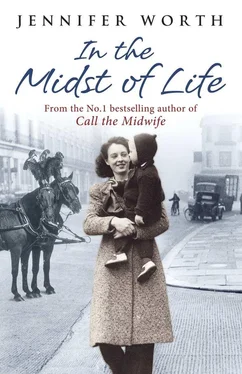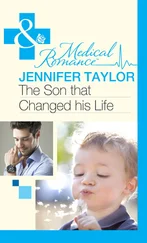Jennifer Worth - In the Midst of Life
Здесь есть возможность читать онлайн «Jennifer Worth - In the Midst of Life» весь текст электронной книги совершенно бесплатно (целиком полную версию без сокращений). В некоторых случаях можно слушать аудио, скачать через торрент в формате fb2 и присутствует краткое содержание. Жанр: Биографии и Мемуары, на английском языке. Описание произведения, (предисловие) а так же отзывы посетителей доступны на портале библиотеки ЛибКат.
- Название:In the Midst of Life
- Автор:
- Жанр:
- Год:неизвестен
- ISBN:нет данных
- Рейтинг книги:3 / 5. Голосов: 1
-
Избранное:Добавить в избранное
- Отзывы:
-
Ваша оценка:
- 60
- 1
- 2
- 3
- 4
- 5
In the Midst of Life: краткое содержание, описание и аннотация
Предлагаем к чтению аннотацию, описание, краткое содержание или предисловие (зависит от того, что написал сам автор книги «In the Midst of Life»). Если вы не нашли необходимую информацию о книге — напишите в комментариях, мы постараемся отыскать её.
In the Midst of Life — читать онлайн бесплатно полную книгу (весь текст) целиком
Ниже представлен текст книги, разбитый по страницам. Система сохранения места последней прочитанной страницы, позволяет с удобством читать онлайн бесплатно книгу «In the Midst of Life», без необходимости каждый раз заново искать на чём Вы остановились. Поставьте закладку, и сможете в любой момент перейти на страницу, на которой закончили чтение.
Интервал:
Закладка:
Parents will almost always ask to be present when their child is being resuscitated. Historically, as with most medical procedures, relatives have been kept outside when cardio-pulmonary resuscitation is being performed. However, there are differing views between the public and healthcare professionals and the Resuscitation Council has published a useful document on their website about this issue. [26] The Resuscitation Council. http://www.resus.org.uk/pages/witness.htm
From the relatives’ and partners’ point of view, being present may help them come to terms with the serious illness or death of a loved one, especially when they can see that everything medically appropriate has been done. The disadvantage is that the reality of resuscitation may prove distressing, particularly if it is traumatic or if they are uninformed. Furthermore, they may physically or emotionally hinder the staff involved in the resuscitation attempt. However, it seems likely that for many relatives it is more distressing to be separated from their family member during these critical moments than to witness them. From the patient’s point of view, most would probably want to have their family present but it would be unusual for the patient to have expressed an advanced directive stipulating the inclusion of specific relatives, partners, carers or friends. For the clinical staff undertaking resuscitation, the presence of relatives could increase stress, affect decision-making, and affect the performance of the staff involved. On the other hand, verbal or physical interference by a relative could be prevented by close supervision and restriction of numbers.
Progressives believe that relatives or partners should be given the opportunity to be with their loved ones at this time, and proper provision must be made for those who indicate that they wish to stay. If resuscitation is to be witnessed by relatives, partners or carers, it is essential that they be supported throughout by appropriately trained clinical staff, and that the resuscitation team leader is prepared for and aware of their presence. Every hospital should have a written policy about the procedure to be followed when relatives, partners or carers request to be present during cardiopulmonary resuscitation and this would normally be the responsibility of the local Resuscitation Committee.
Modern resuscitation methods and techniques date from the many major advances in research and development of medical practice in the 1950s and 1960s. Changes since then have mainly resulted in improvements in existing procedures, rather than in the development of new medical treatments; consequently, improvements in the outcome of cardio-pulmonary resuscitation have been relatively small. The introduction of cardio-pulmonary resuscitation in the 1960s, as with many new drugs or medical procedures, resulted in initial scepticism, followed by enthusiasm, leading to over-enthusiasm and over-use, until a more precisely defined usage becomes established. With the development of procedures, medical practice has run ahead of many of the moral and ethical issues involved in resuscitation decisions. Most of these issues, such as the applicability of Do Not Attempt Resuscitation orders and Advanced Decisions, are now being reassessed so that they come into line with current medical practice.
In general, the success rates of cardio-pulmonary resuscitation remain disappointingly low, especially in out-of-hospital resuscitation, and it does not seem likely that developments in the near future will substantially help to improve the situation. In my view, the most helpful development would be for clinicians to be able to define in advance which people and which conditions are most likely to have a successful outcome, and which will not; there is an obvious need to be more selective about for whom, when and where we undertake cardio-pulmonary resuscitation although this is clearly much easier to do for patients in hospital.
Sudden collapse and death are in fact very rare in healthy people, and are probably becoming even rarer in countries that have falling mortality rates from heart disease. The greatest challenge is to understand when there is likely to be little or no benefit from cardiopulmonary resuscitation, and to identify more systematically those people in advance. By doing this, death could be managed in a better and more humane way – which is the whole point of this book.
In the end, doctors cannot cheat death; we can only delay it.
APPENDIX II
THE PARAMEDIC’S TALE
By Louise Massen, Clinical Team Leader, Thameside Ambulance Station, South East Coast Ambulance Service (SECAMB)
I joined Kent Ambulance Service on the i April 1993.I am second-generation ambulance service and absolutely love my job with a passion! There is nothing else I ever want to do.
We received a three-month residential training course, which was run by a specialist ambulance training college. The course encompassed emergency driving, manual handling, and the specialist ambulance aid skills required to use the equipment we need to treat a whole host of medical, traumatic and obstetric calls.
I graduated in July 1993 and was posted to Dartford Ambulance Station of North Kent. I was proud to work at the station where my father had worked for twenty years. In his day, the ambulance equipment consisted of a basic stretcher, some oxygen, a few bandages and wooden splints, and lots of blankets. I was trained in manual cardiac defibrillation, could take a blood pressure, and use a whole host of splinting and moving equipment to handle the high-speed trauma that we were increasingly being called to deal with.
By 1995 I had completed the extended training by the National Health Service Training Directorate (NHSTD), and was deemed a ‘qualified ambulance paramedic’. My new skills included intravenous cannulation and infusion (this meant I could insert a needle over a catheter into a patient’s vein to administer IV drugs or fluids), endotracheal intubation (a plastic tube which sits in the patient’s trachea or windpipe to facilitate a patent airway whilst unconscious), intraosseous cannulation (screwing a needle into a bone to allow drug access), and a more detailed approach to cardiac ECG interpretation.
Surely and slowly, medical progress has been made and many new protocols, policies and procedures have found their way into the ambulance service. Paramedics these days are proficient in 12-lead ECG interpretation, can diagnose and provide definitive treatment for myocardial infarction by administering thrombolytic clot-busting drugs – every minute a coronary artery is occluded depletes life by about eleven days – so our early intervention and treatment in the pre-hospital setting is improving the quality of many patients’ lives, as well as the quantity who survive.
New paramedics, these days, are trained by universities with the emphasis more on education and less on the sort of vocational training that I completed. The new cohorts of paramedics are selected from those who successfully complete a three-year degree course, with the opportunity for all paramedics to extend their training to become paramedic practitioners (PPs) and critical care paramedics (CCPs).
The paramedical degree courses are separated into academic modules covering a range of subjects such as introduction to medical care, trauma care, public health immunology, and foundations of paramedic practice, which covers use of ambulance equipment and clinical skills, and the different sections of anatomy and physiology which are broken down into the various systems of the body – cardiology, neurology etc.
Читать дальшеИнтервал:
Закладка:
Похожие книги на «In the Midst of Life»
Представляем Вашему вниманию похожие книги на «In the Midst of Life» списком для выбора. Мы отобрали схожую по названию и смыслу литературу в надежде предоставить читателям больше вариантов отыскать новые, интересные, ещё непрочитанные произведения.
Обсуждение, отзывы о книге «In the Midst of Life» и просто собственные мнения читателей. Оставьте ваши комментарии, напишите, что Вы думаете о произведении, его смысле или главных героях. Укажите что конкретно понравилось, а что нет, и почему Вы так считаете.












